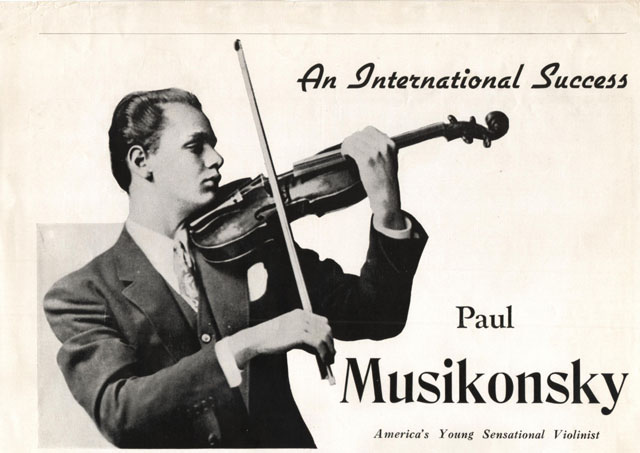

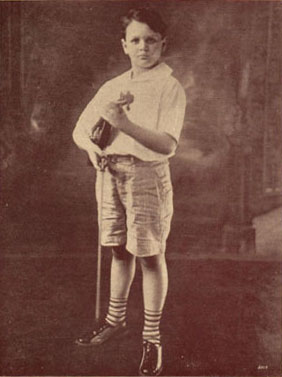
An introduction was arranged to Osip Ovzerovitch, concert master of the Vitagraph orchestra and himself an outstanding violinist who along with Yascha Heifetz, Efram Zimbalist, Mischa Elman and Nathan Milstein had been a student of Leopold Auer at the Imperial Conservatory in St. Petersburg Russia. At their first meeting, Osip was very impressed with the boy's playing. For young Paul it was a turning point in his life. For years thereafter, Osip not only became the young student's teacher, he became his mentor and friend as well.
In 1925, when Paul was five, he started kindergarten at a neighborhood school in Brooklyn but soon dropped out because he found in his new relationship with Osip he would want to study with him several times a week. So enthusiastic was he about his ability to make music he would get up at six in the morning go to the basement of his house and practice what Osip had taught him the day before. And then, that same afternoon, his mother would drive him to Osip's for an extended lesson.
When he was eight, he would sometimes take the trolley car with his sister, who was ten. She would drop him off and go to visit their grandmother nearby. As Paul grew to know the conductors on the line, they grew to watch him to see that he stayed safe while he studied the music and read the daily newspaper.
All during those years and after, Osip's family played an important role in the artistic growth of the gifted violinist. As refugees from Russia, where their home had been set on fire during the revolution, they fled to Turkey with nothing but Osip's precious Guadagnini violin. There they lingered for several months while Osip earned enough money playing the violin to pay for steamship tickets to the U.S.
In time Paul learned to understand and speak Russian. He also listened to Osip play chamber music and even prepare music for Osip's commercial Videograph work. In all, Paul was soon swept into the world of music on the bow of his beloved violin. Osip was a most demanding and stern teacher, who had no regard for the fact that Paul was just a child. He demanded that Paul quickly accomplish what he thought were important musical goals and objectives. He taught Paul with all the nuances and variations of playing the violin, just as he had been taught in Russia.
Osip soon recognized that Paul had the potential to become an important artist and he started to mold Paul, as he himself had wished to be. After several months, Osip told Paul's parents that since he was convinced Paul had the potential to be a great violinist, he was willing to give up all his other pupils and concentrate all his energies and talent to develop Paul into the great artist he would become.
One of Paul's father's great loves was opera; music meant a great deal to him and there was nothing that he wouldn't do for his children. Fortunately, Paul's father was a successful business man and told Osip that he would find the money to pay him a weekly income to have him nourish Paul's talent. Osip gave up all his other teaching activities and started to come to Paul's home every day except Sunday and stayed with him from early in the morning till evening.
After three years, Osip advised Paul's parents that his young protege would soon be ready to give concerts. Because Russian artists were taken more seriously, it was decided to have Paul have a Russian sounding name and perform with the stage name Paul Musikonsky.
Paul
began
his
career by giving complimentary performances at orphanages,
hospitals,
charitable institutions and schools, to give him the
necessary
confidence
and to become accustomed to playing before large audiences.
Arrangements
were made for Paul to audition for the composer Deems Taylor
and Henry
Hadley the conductor of the Manhattan Symphony Orchestra.
Hadley was
enthralled
by his playing and engaged him to perform with the
orchestra. All the
newspaper
critical reviews were fabulous, such as:
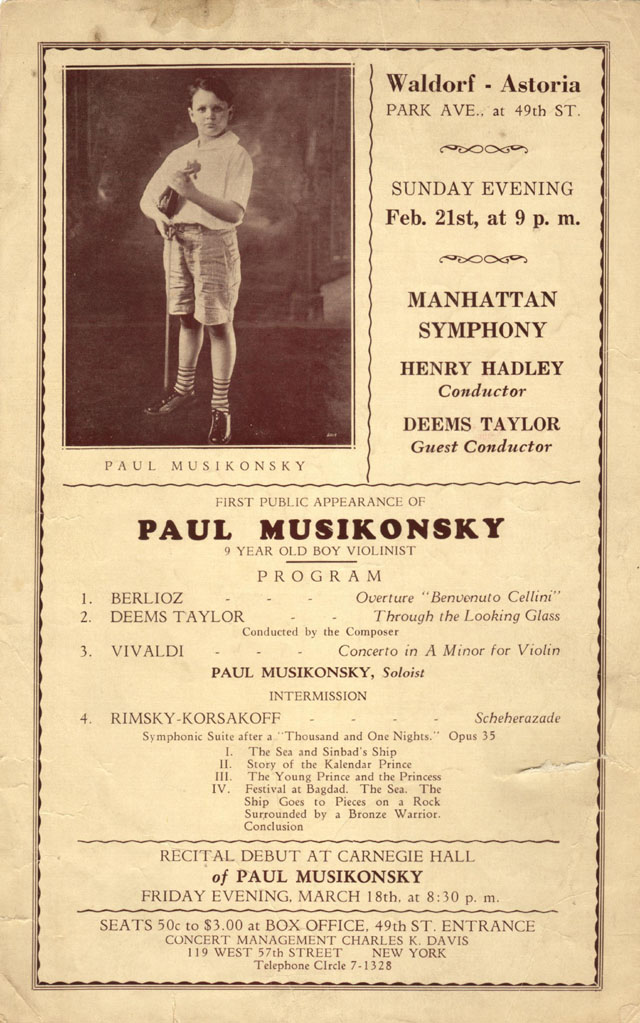
New
York
Herald Tribune
"Musikonsky
displayed
technical dexterity, thorough command; tasteful and
musicianly
interpretation"
Paul
then
went
on a concert tour throughout Canada with following critical
reviews
from some major cities.
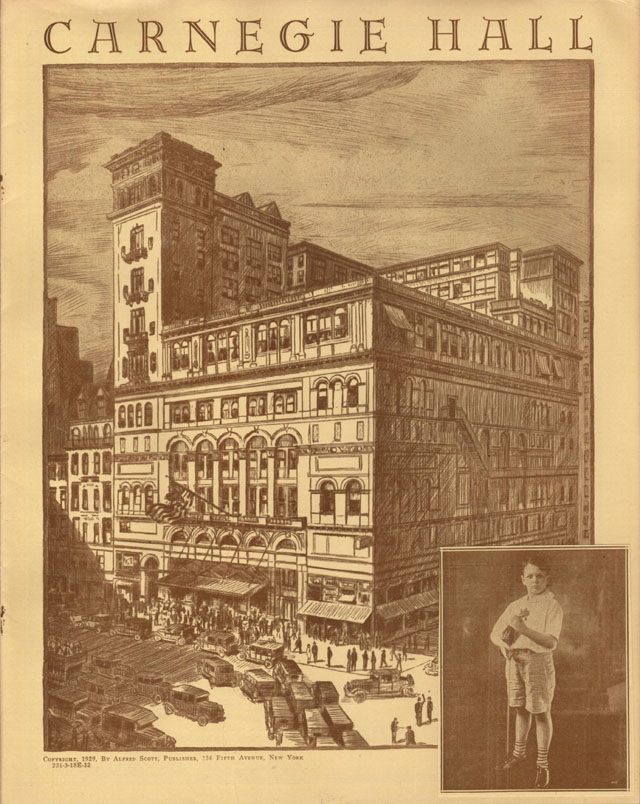
Montreal
Daily
Star
"His
bowing
was free and his double stopping very remarkable"
Ottawa
Citizen
"Paul
Musikonsky,
genius, gives amazing violin recital for Ottawa audience.
Invaluable
asset
of absolute pitch. Tone was clear, sweet, beautifully
even,
intellectual
grasp...artistic genius...brilliant performance"
After returning from the very successful tour throughout Canada, Paul then gave a recital in Carnegie Hall and the New York music critics declared that they were astonished by the obvious musical gifts that Paul displayed. Again the concert received great critical notice, such as:
New
York
Times
"A
violinist
of solid and laudable attainments"
World
Telegram
"Violinist
astonishes
Carnegie Hall audience"
Brooklyn
Daily
Eagle
"Has
imagination
and beauty which is one of the qualities of a genius"
Thanks
to
the glowing critiques of young Musikonsky's performances,
newspapers
everywhere became very interested in his career and
predicted he would
be the next Yehudi Menuhin. In response his career and
travels soared.
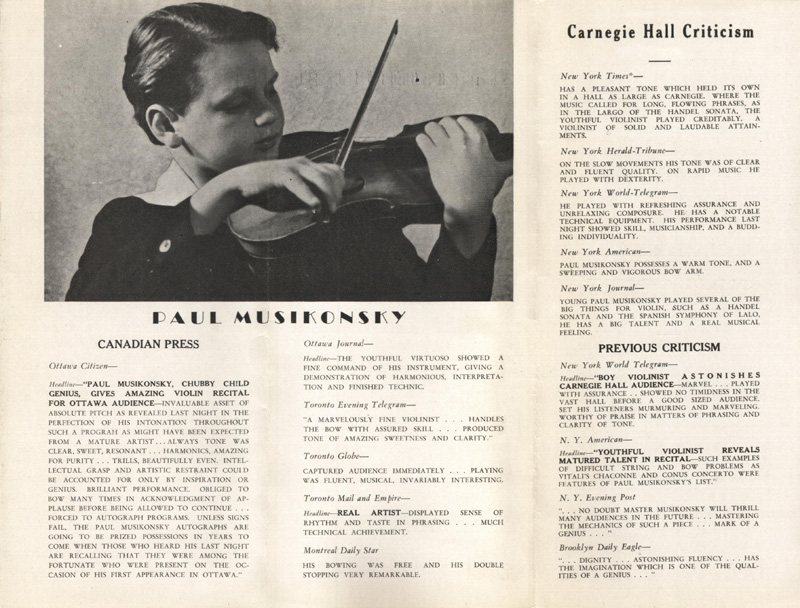
It was the first ocean voyage of many for Paul. He loved traveling, eating at the Captain's table and performing for the passengers. His first trip across the Atlantic on the USS Pilsudski was particularly memorable, because after four days the ship ran into a severe storm and was in a perilous state causing the captain to sail in the opposite direction for two days. The ship was rolling to such a degree, that very few passengers could stand or go to the dining room to eat, except Paul who loved the excitement and was the only one that could eat. When the ocean calmed down, Paul gave a concert for his fellow passengers.
Again
the
concert
management agency Van Wyck arranged concerts in all the
major
cities
of Europe and the concerts were a great success. The
European
international
press critical reviews were even more glowing than in
America, such as:
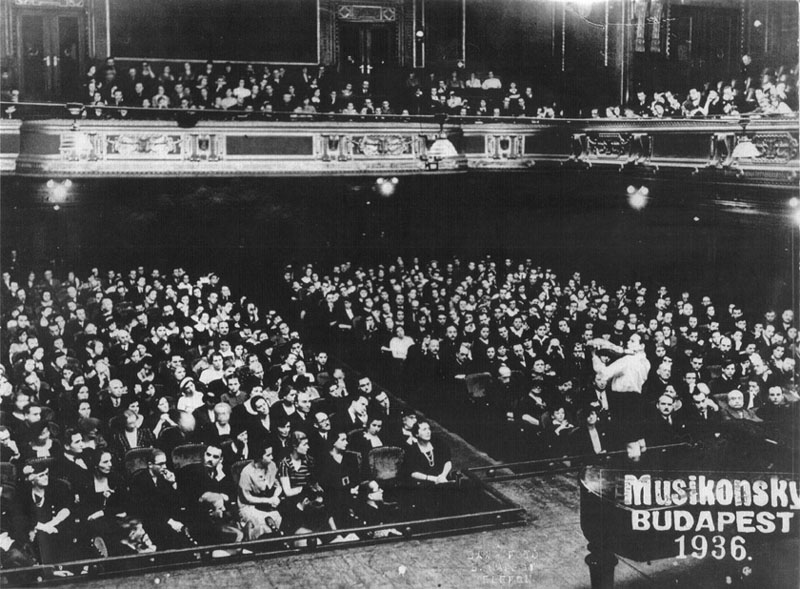
Pester
Lloyd
"Everything
is
natural and unspoiled about him - even his art. Music is
in his
name,
and music is in his whole being"
Warsaw
"Paul
Musikonsky,
violin virtuoso, possesses an inborn musical feeling,
beautiful vibrant
tone and extraordinary bow arm"
London
Sunday
Times
"His
technique,
musical ability and sense of time appears to be inborn"
Pesti
Hirlap
"With
the
fresh charm of a strong young tree, he stands upon the
platform and
plays
in a manner to astonish his audience. His tone is angelic"
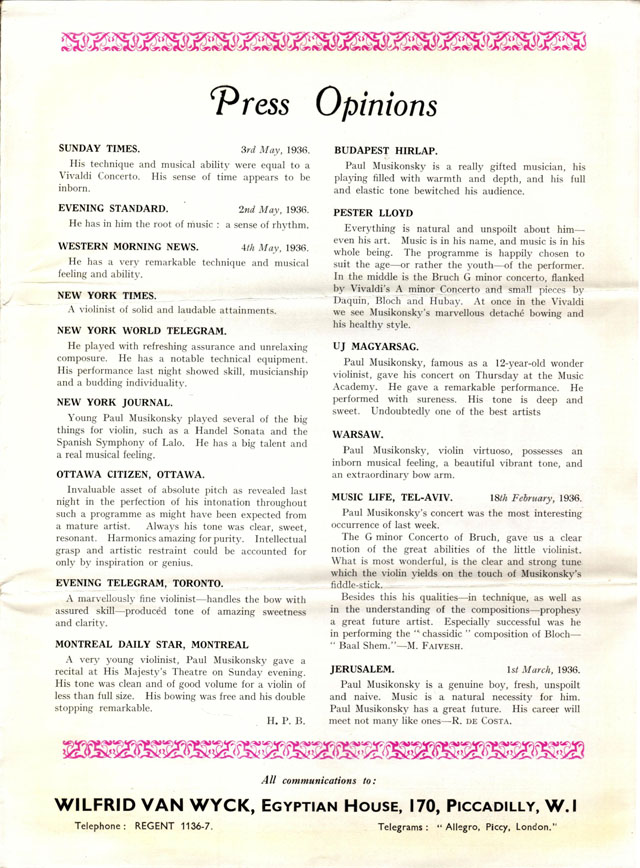
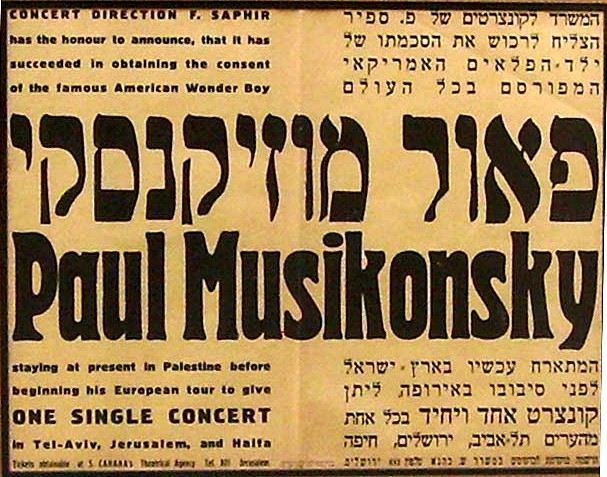
Before Israel was a nation,
Palestine became the mecca for some of the great
artists who
were fleeing Europe for safety in Palestine and Paul was
invited to
perform there and toured Palestine three times in 1934,
1936 and
1938. The poster is similar to
hundreds of
posters that were attached to outdoor Kiosks advertising
concerts, because in the 1930’s, there was no
commercial radio
or TV. Similar posters were
also used in
Europe, U.S. and Canada.
Through Google, Yahoo and E-Bay, there still are several different Paul Musikonsky (Paul Lennard) antique posters and programs from various concerts, being sold by collectors.
***********************************************************
Haaretz
"When
Paul
Musikonsky plays, one's ear is caught by deep crystal
clear sound and
horizon
wide song that penetrates one's soul"
Doar
Hayom
"When
Paul
Musikonsky played his violin, I soared high on the wings
of song. He
lowered
me into the depths, and upheaved me into the unknown"
Palestine
Post
"Paul
Musikonsky
has a great future. Music is a natural necessity for him.
His career
will
meet not many like ones"
Palestine
Music
Life
"Paul
Musikonsky
gave us a clear notion of his great abilities and I
prophesy a great
future
artist"
Paul
then
returned
to the U.S. with performances throughout the U.S. and again
in
Carnegie Hall with Emanuel Bay, the accompanist of Yascha
Heifetz.
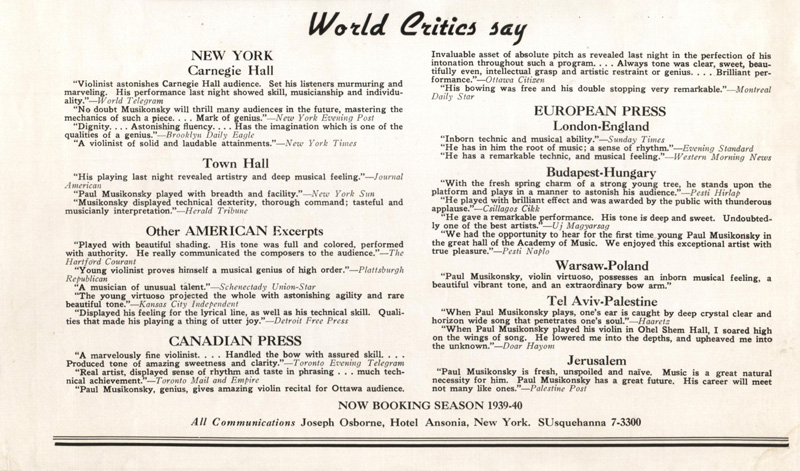
He was invited again to return to play in Palestine in 1938 with its symphony orchestra and in recitals. The Palestine Symphony Orchestra (later it changed its name to the Israel Philharmonic) now was enlarged with many prominent Jewish musicians who fled Germany and Austria including Bronislav Huberman who had invited Auturo Toscanini to conduct. Paul appeared in several concerts (in Tel Aviv, Jerusalem and Haifa) as soloist to great critical reviews.
After
Palestine,
in the winter of 1938 and 1939 Paul again toured throughout
Europe
playing
the Brahms, Vieutemps and Beethoven concertos as well as the
major
sonatas.
While performing in Europe and living in Warsaw, war
rumblings became
very
intense after Hitler invaded the Sudatenland and it was
decided that he
should leave Europe and return to the U.S.
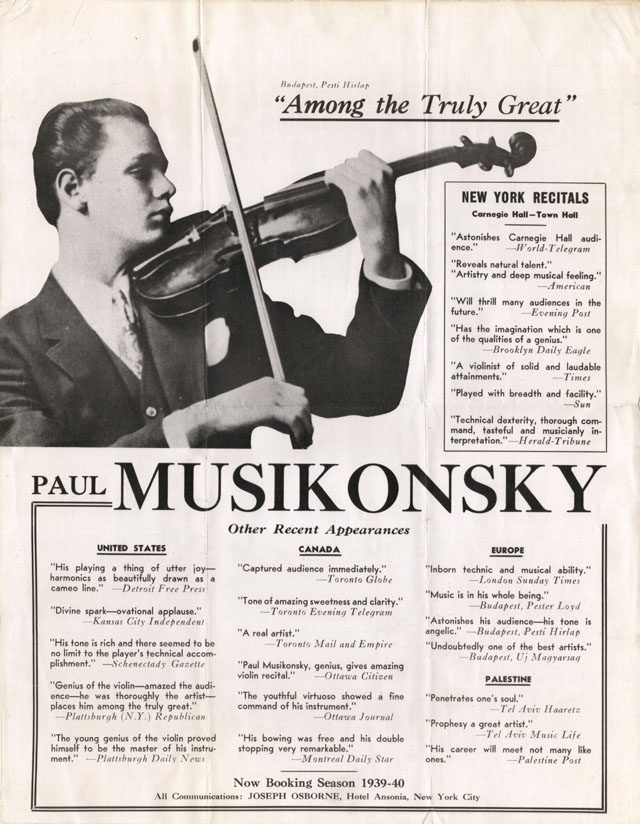
In 1940-41 Paul gave concerts in the U.S.A. until he received a military draft notice. The draft board offered him a choice to become a member of the U.S. Navy Band, which he declined. Paul had a friend, who was a writer and was drafted into the Navy Recruiting Bureau to write 'The Navy Needs You' radio scripts. He told Paul that he would introduce him to the head of the Naval Intelligence of the Third Naval District. That possibly they would be interested in Paul because he spoke French and Russian and traveled extensively in Europe and the mid-east.
Paul's background was of interest to them and he entered the U.S. Naval Reserve on active duty before Pearl Harbor and was recruited to go to school to become a cryptoanalyst in the Naval Intelligence. He was sent to Hunter College in New York City to learn about the use of "the frequency of language used in codes," but Paul did not like sitting in a classroom and wanted more physical activity. He heard that the Navy was recruiting photographers from major magazines like Life Magazine, Coronet and Look Magazine to get involved in a new photographic group that was being formed. Because of his keen interest in photography and his past experiences taking his own pictures in his travels, and his ability to develop film and print and enlarge pictures, he requested a transfer to be assigned to the new photographic group.
He
was
assigned to the Atlantic Fleet Camera Party and was sent to
a sea going
ship the USS Alcor, where he got training and instruction on
using and
working with some of the very first color photography. He
was then
assigned
at sea to a photographic group that went from ship to ship
and did the
triangulation testing of the military cannons on naval
vessels and on
cargo
ships that were in military convoys going to England and
Russia. Later
in the war, he was assigned to Texas A&M doing
photography on
R&D
work of Radar and then was assigned as a photographer flying
on fixed
wing
aircraft and then on 'Lighter than Air' Blimps.

On his way to a rehearsal in Copenhagen with his violin, a freak accident on a train that hit a car broke Paul's elbow and wrist as well as tearing the tendons and ligaments of his left hand and arm. He developed severe calcification and returned to the U.S. with a plaster cast that stayed on for several months. Because the left hand of a violinist is vital to his playing, Paul was left with a permanent disability and was forced to redirect his life.
Paul
passed away July 29, 2020. He had two sons: Alan and Spencer
and was preceded to death by his wife Irene Lennard (June
14, 2012).
Photo
of Paul and Irene soon after they were married
